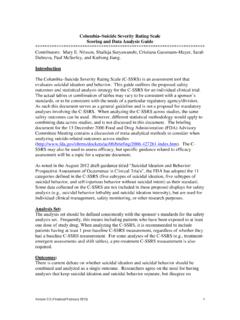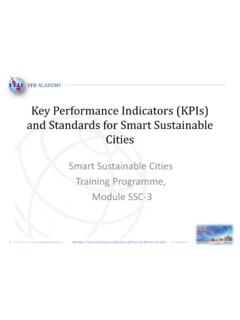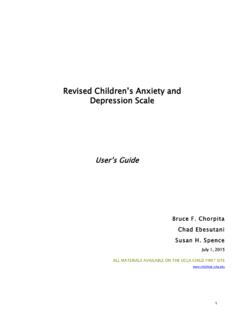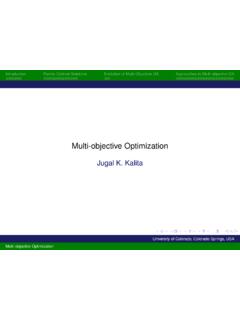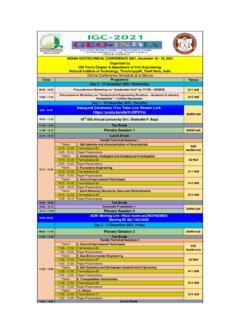Transcription of Measuring and Evaluating Workload: A Primer
1 NASA/TM 2010-216395 Measuring and Evaluating workload : A Primer Stephen M. Casner, NASA Ames Research Center, Moffett Field, CA Brian F. Gore, San Jose State University Research Foundation, San Jose, CA July 2010 NASA STI Profile Since it s founding, NASA has been dedicated to the advancement of aeronautics and space science. The NASA scientific and technical information (STI) program plays a key part in helping NASA maintain this important role. The NASA STI program operates under the auspices of the Agency Chief Information Officer. It collects, organizes, provides for archiving, and disseminates NASA s STI.
2 The NASA STI program provides access to the NASA Aeronautics and Space Database and its public interface, the NASA Technical Report Server, thus providing one of the largest collections of aeronautical and space science STI in the world. Results are published in both non-NASA channels and by NASA in the NASA STI Report Series, which includes the following report types: TECHNICAL PUBLICATION. Reports of completed research or a major significant phase of research that present the results of NASA Programs and include extensive data or theoretical analysis. Includes compilations of significant scientific and technical data and information deemed to be of continuing reference value.
3 NASA counterpart of peer-reviewed formal professional papers but has less stringent limitations on manuscript length and extent of graphic presentations. TECHNICAL MEMORANDUM. Scientific and technical findings that are preliminary or of specialized interest, , quick release reports, working papers, and bibliographies that contain minimal annotation. Does not contain extensive analysis. CONTRACTOR REPORT. Scientific and technical findings by NASA-sponsored contractors and grantees. CONFERENCE PUBLICATION. Collected papers from scientific and technical conferences, symposia, seminars, or other meetings sponsored or co-sponsored by NASA. SPECIAL PUBLICATION.
4 Scientific, technical, or historical information from NASA programs, projects, and missions, often concerned with subjects having substantial public interest. TECHNICAL TRANSLATION. English-language translations of foreign scientific and technical material pertinent to NASA s mission. Specialized services also include creating custom thesauri, building customized databases, and organizing and publishing research results. For more information about the NASA STI program, see the following: Access the NASA STI program home page at E-mail your question via the Internet to Fax your question to the NASA STI Help Desk at (301) 621-0134 Phone the NASA STI Help Desk at (301) 621-0390 Write to: NASA STI Help Desk NASA Center for AeroSpace Information 7121 Standard Drive Hanover, MD 21076-1320 NASA/TM 2010-216395 Measuring and Evaluating workload : A Primer Stephen M.
5 Casner, NASA Ames Research Center, Moffett Field, CA Brian F. Gore, San Jose State University Research Foundation, San Jose, CA National Aeronautics and Space Administration Ames Research Center Moffett Field, California 94037 July 2010 Acknowledgements This research was funded by NASA s Space Human Factors Engineering Project of the Human Research Program (WBS 466199). The authors would like to express sincere appreciation to all reviewers for their input on this document. The use of trademarks or names of manufacturers in the report is for accurate reporting and does not constitute an official endorsement, either expressed or implied, of such products or manufacturers by the National Aeronautics and Space Administration.
6 Available from: NASA Center for AeroSpace Information NASA Center for Aerospace Information 7121 Standard Drive 7121 Standard Drive Hanover, MD 21076-1320 Hanover, MD 21076-1320 (301) 621-0390 (301) 621-0390 iii Table of Contents 1. Why Measure and Evaluate workload ?..1 Challenges to Measuring Challenges to Evaluating 2. Measuring Performance Measuring Speed and Measuring Task Indirect Subjective Subjective Numerical Measurement Subjective Comparative Measurement Physiological Heart Heart Rate Evoked Advantages and Disadvantages of Physiological 3. Evaluating Is workload Too High or Too Low?
7 15 How Does workload Compare between Several Tasks or Designs?..16 Undertaking a workload Measurement and evaluation Formulate Choose workload Measurement Technique(s)..17 Prepare Materials for Data Choose and Instruct Participants and Gather Analyze Data and Draw An Example: Using a Flight Management Task to be Questions to be Choosing workload Measurement Preparing Collecting the Analyzing the Data and Drawing 4. 5. iv 1 Abstract The workload directed research project surveyed the available literature on: workload measurement techniques; and, the effects of workload on operator performance.
8 Two sets of findings were generated. The first set provided practitioners with a collection of simple-to-use workload measurement techniques along with characterizations of the kinds of tasks each technique has been shown reliably to address. The second set provided practitioners with the guidance needed to design for appropriate kinds and amounts of workload across all tasks for which the operator is responsible. The criterion for inclusion into the EndNote reference list database limited the articles to those that were peer reviewed, long standing and accepted in the field, applicable to a relevant range of conditions in a select domain of interest, with parallels being drawn in an attempt to identify analogous extreme environments to those in space.
9 Research points towards no one, single approach to determine the suitability of workload in various operational contexts. Different workload evaluations are needed at different phases of the development cycle. The workload toolbox and the Primer can assist in the selection decision of how and when to use a select set of workload measurement tools. 1. Why Measure and Evaluate workload ? Human factors researchers have long been interested in the link between workload and human performance. The earliest studies quickly revealed the deleterious effects of workload that is either too high or too low. Humans who are overburdened with work tend to hurry their performance, commit more errors, yield poor accuracy, become frustrated, uncomfortable, and fatigued, and have poor awareness of their surroundings.
10 Interestingly, humans who are underworked can exhibit many of the same symptoms. Low workload has been linked to high error rates, frustration, fatigue, and poor awareness of surroundings as they become bored, as their attention drifts, and as complacency sets in. From all we have learned, it seems that humans do their best when their skills are exercised and their abilities challenged, are neither bored nor overburdened, and when periods of work and rest are equitably mixed together. These observations about workload and the quality of human performance leave us with two problems. The first problem is that we need a Measuring device for workload .
